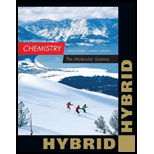
Concept explainers
(a)
Interpretation:
pH of
Concept Introduction:
pH definition:
The concentration of hydrogen ion is measured using pH scale. The acidity of aqueous solution is expressed by pH scale.
The pH of a solution is defined as the negative base-10 logarithm of the hydrogen or hydronium ion concentration.
The
(a)
Explanation of Solution
Given,
Volume of acid in liters:
Original mole
The given solution contains only
(b)
Interpretation:
pH of the solution has to be calculated, after addition of
Concept Introduction:
Refer part (a).
(b)
Explanation of Solution
After the addition of the titrant,
To determine the equilibrium concentration of
(c)
Interpretation:
pH of the solution has to be calculated, after addition of
Concept Introduction:
Refer part (a).
(c)
Explanation of Solution
Used the equation in (b), again
Volume of base (L)
(d)
Interpretation:
pH of the solution has to be calculated, after addition of
Concept Introduction:
Refer part (a).
(d)
Explanation of Solution
The volume and total moles of base can be calculated as
Total moles of
(e)
Interpretation:
pH of the solution has to be calculated, after addition of
Concept Introduction:
Refer part (a).
(e)
Explanation of Solution
At equivalent point, the moles of base begin to exceed the moles of acid, so we adapt the expression we used in (b) for a solution with excess base to determine the equilibrium concentration of
The solution has a
(f)
Interpretation:
pH of the solution has to be calculated, after addition of
Concept Introduction:
Refer part (a).
(f)
Explanation of Solution
The pH of equivalent point of titrant can be calculated as
Hence, the results in a pH verses volume of titrant to make a titration curve, including equivalence point:

Want to see more full solutions like this?
Chapter 15 Solutions
Chemistry: The Molecular Science, Hybrid Edition (with OWLv2 24-Months Printed Access Card)
- Vitamin C is ascorbic acid (HC6H7O6), for which Ka is 8.0105. Calculate the pH of a solution made by dissolvinga 500-mg tablet of pure vitamin C in water anddiluting to 100 mL.arrow_forwardThe weak base, CIO (hypochlorite ion), is used in the form of NaCIO as a disinfectant in swimming pools and water treatment plants. What are the concentrations of HCIO and OH and the pH of a 0.015 M solution of NaCIO?arrow_forwardConsider citric acid, H3C6H5O7, added to many soft drinks. The equilibrium constants for its step-wise ionization areKa1=7.5104 ,Ka2=1.7105, andKa3=4.0107. Write the overall net ionic equation and calculate K for the complete ionization of citric acid.arrow_forward
- The concentration of CH3COOH (pKa=4.75) in vinegar is about 1.0 M. With this what do you predict the pH of vinegar to be?arrow_forwardDetermine the pH of a 1.497 M solution of potassium cyanide (KCN) in water. Ka for HCN is 6.17 × 10–10. Enter your response in pH units to the nearest 0.01.arrow_forwardAcetominophen, HC8H8NO2 (MM=151.17 g/mol), is the active ingredient in Tylenol, a common pain reliever. A solution is made by dissolving 6.54g of acetaminophen in enough water to make 250.0 mL of solution. The resulting solution has a pH of 5.24. What is the Ka for acetaminophen?arrow_forward
- If a buffer solution is 0.180 M in a weak base (Kb=7.5×10−5) and 0.400 M in its conjugate acid, what is the pH?arrow_forwardIf titrating 25.00 mL of 0.115 M HCl with 0.0955 M NaOH, what is the pH of the solution after 10.48 mL of NaOH has been added?arrow_forwardThe pH of a 0.060 M monophotic acid is 3.44 calculate the K, of the acid?arrow_forward
- The pH of a solution that contains 1.2M acetic acid and 0.920M sodium acetate is?arrow_forwardA chemist adds a chemical to pure water and there is a 100-fold incre approximation of the new pH value?arrow_forwardAn episode of CSI: Miami had a deceased victim floating in a swimming pool contaminated with sodium hydroxide. The concentration was high enough to eat through glass. When the CSI guys realized it was alkali (ie., a base) they knew they needed to neutralize it in order to retrieve the body so they sent one of their team to a local store for vinegar. They proceeded to pour vinegar from a couple of gallon jugs into the pool, dropping the pH from 14 to exactly 7.0 all within a few seconds, and without any stirring! The volume of swimming pool is 100,000L. Vinegar is approximately a 1.0 M of acetic acid, HC2H3O2, a monoprotic acid. A pH of 14 is equivalent to 1.0 M solution of sodium hydroxide,NaOH. Using your knowledge of chemistry, comment on whether or not the events described in the episode of CSI: Miami could take placearrow_forward
 Principles of Modern ChemistryChemistryISBN:9781305079113Author:David W. Oxtoby, H. Pat Gillis, Laurie J. ButlerPublisher:Cengage Learning
Principles of Modern ChemistryChemistryISBN:9781305079113Author:David W. Oxtoby, H. Pat Gillis, Laurie J. ButlerPublisher:Cengage Learning Chemistry & Chemical ReactivityChemistryISBN:9781337399074Author:John C. Kotz, Paul M. Treichel, John Townsend, David TreichelPublisher:Cengage Learning
Chemistry & Chemical ReactivityChemistryISBN:9781337399074Author:John C. Kotz, Paul M. Treichel, John Townsend, David TreichelPublisher:Cengage Learning Chemistry: Principles and ReactionsChemistryISBN:9781305079373Author:William L. Masterton, Cecile N. HurleyPublisher:Cengage Learning
Chemistry: Principles and ReactionsChemistryISBN:9781305079373Author:William L. Masterton, Cecile N. HurleyPublisher:Cengage Learning




